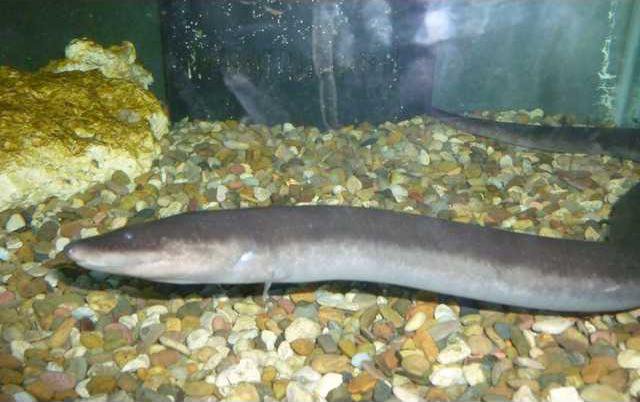One of the newest animals at Great Bend’s Brit Spaugh Zoo goes by an alias.
The so-called Congo eel isn’t an eel at all, said Zoo Director Scott Gregory. It’s actually an amphibian – a salamander that can exist outside of water. And although it is often called Congo eel, Congo snake or lamper eel, the correct name for this critter is amphiuma (am-fee-oo-ma).
The zoo has two amphiumas and a greater siren (another amphibian) on display in its aquariums. Look closely and you’ll see the amphiumas actually have four limbs, although they are tiny and all but useless. They can pose a danger to humans in the wild, however. They can grow to over 3 feet long and they have strong jaws with a double row of razor sharp teeth that can deliver a savage bite.
Amphiumas come in one- two- and three-toed varieties. The two-toed amphiumas at Brit Spaugh Zoo have a Species Survival Plan under the Association of Zoos and Aquariums (AZA).
“They’re part of the Species Survival Plan because their habitat is dying,” Gregory said. Amphiuma can be found primarily in Florida swamps and other southern wetlands, but some of its habitat has been polluted with wastewater. Another giant amphibian from southern U.S. wetlands that can now be found at the Great Bend zoo is the greater siren. While similar in appearance to amphiuma, it has two forelimbs and external gills.
As Great Bend’s zoo continues to work toward becoming AZA-accredited, the staff looks at species preservation and breeding opportunities.
“We’ve just added our lemur to the (AZA) studbook,” Gregory said. Now that the ring-tailed lemurs and serval cats have been entered into the studbook, they can be used for breeding programs.
There are plans to find mates for some animals. For example, the zoo may trade its servals for a breeding pair from Australia. The current pair isn’t suitable for breeding because of the inbreeding of zoo animals over the years, the director said.
When the Brit Spaugh Zoo acquired a female arctic fox in December of 2012, Gregory said there were plans to get a mate for her. That is still the plan, but the male fox the zoo has been promised hasn’t been born yet. The arctic fox also has an AZA Species Survival Plan.
More to come
“We’ve got a lot of stuff in the works right now,” Gregory said. Two Jamaican boas, another species with survival concerns, are in the new-animal quarantine area of the zoo. A new Snake House exhibit is scheduled to open by the end of the month. The boas will be on display, as well as a green tree python, king snakes and rat snakes.
The zoo will also be adding playground equipment this summer. The equipment was purchased after the Nex-Tech Zoo Fest, which drew close to 2,000 people. A $1,500 donation from Nex-Tech helped finance the playground equipment. Local Boy Scouts will install it.
Gregory said he’s also expecting a visit/inspection from Brit Spaugh Zoo’s AZA mentor, Stacy Johnson, director of Living Desert Zoo in California. The AZA conference is in Kansas City this year from Sept. 7-14, and Johnson will come to Great Bend shortly before the conference gets under way.
According to Gregory’s report to the Great Bend City Council last Monday: “From this inspection we will see if we can re-apply (for AZA accreditation) next year. So far our written application is fully reviewed and there are only a small amount of corrections that need to be done. Our written application is very solid.”





